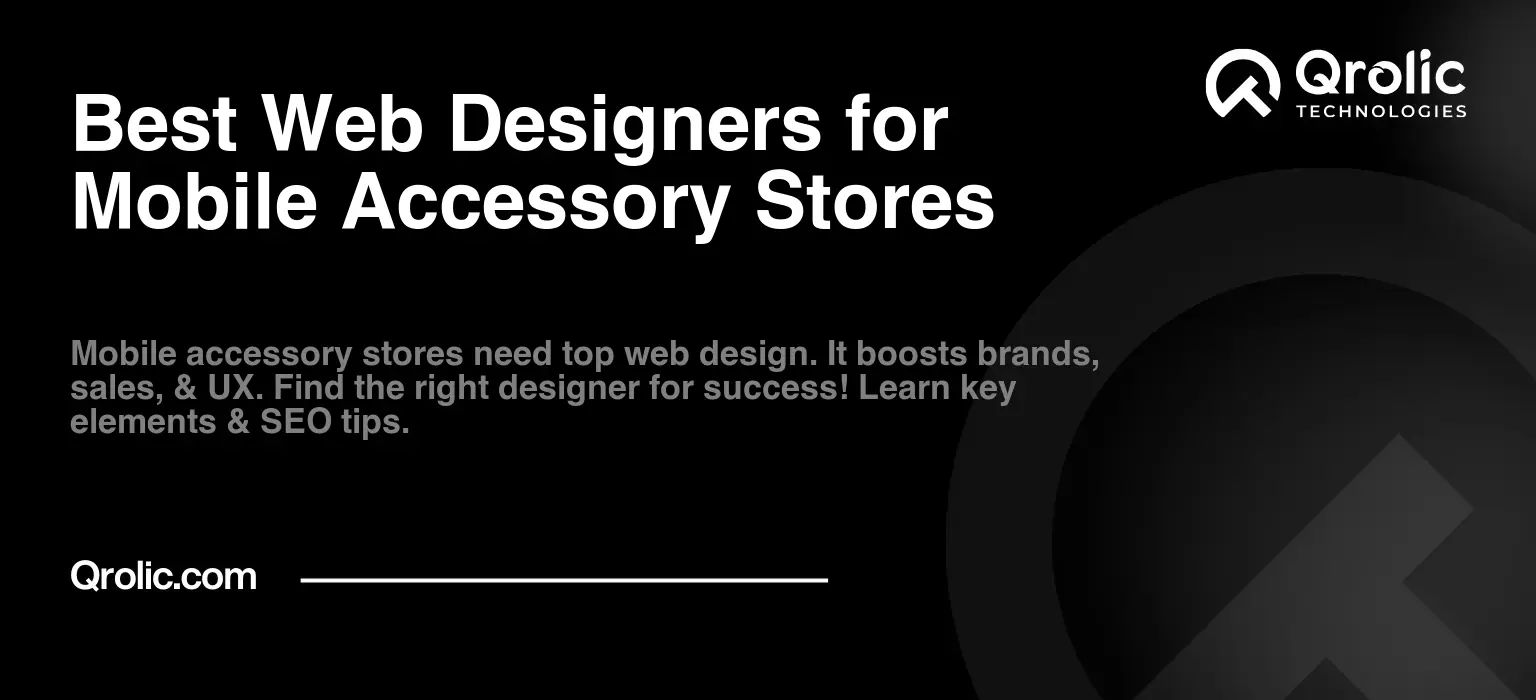Quick Summary:
- A professional website drives sales and builds brand.
- Focus on visually appealing design and easy navigation.
- Choose web designers with e-commerce and SEO expertise.
- Optimize your site for search engines after launch.
Table of Contents
- The Vital Role of Web Design for Mobile Accessory Businesses
- Why a Professional Website is a Must for Mobile Accessory Retailers
- Key Elements of Effective Web Design for Mobile Accessories
- 1. Visually Appealing Design
- 2. User-Friendly Navigation
- 3. Detailed Product Pages
- 4. Secure Checkout Process
- 5. Customer Support
- Finding the Right Web Designer for Your Mobile Accessory Store
- 1. Experience in E-commerce Web Design
- 2. Design Skills and Creativity
- 3. Technical Proficiency
- 4. Communication and Collaboration
- 5. Budget and Timeline
- Qrolic Technologies: Your Partner in Web Design for Mobile Accessory Stores
- Why Choose Qrolic Technologies for Your Mobile Accessory Store Web Design?
- Key Features We Offer for Mobile Accessory Stores
- How Qrolic Technologies Can Help You Grow Your Mobile Accessory Business
- Step-by-Step Guide to Finding the Right Web Designer
- Optimizing Your Mobile Accessory Website for SEO
- 1. Keyword Research
- 2. On-Page SEO Optimization
- 3. Off-Page SEO Optimization
- 4. Technical SEO Optimization
- 5. Local SEO
- 6. Monitor and Analyze
- Conclusion
The Vital Role of Web Design for Mobile Accessory Businesses
In today’s hyper-connected world, a mobile accessory store’s online presence is no longer a luxury; it’s a necessity. Potential customers are constantly searching for the latest phone cases, screen protectors, headphones, and other accessories online. A poorly designed website can lead to lost sales, frustrated customers, and a missed opportunity to establish a strong brand. Web design for mobile accessory stores is not just about aesthetics; it’s about creating a seamless, user-friendly experience that encourages browsing, builds trust, and drives conversions. A great website acts as a 24/7 sales representative, showcasing your products to a global audience.
Why a Professional Website is a Must for Mobile Accessory Retailers
Think of your website as the digital storefront for your mobile accessories business. It’s the first impression many potential customers will have of your brand. Here’s why professional web design is non-negotiable:
- Enhanced Brand Image: A well-designed website projects professionalism and credibility, telling customers you’re a reputable business that takes its products and services seriously. A poorly designed site, conversely, can signal a lack of care, leading customers to question the quality of your products.
- Improved Customer Experience: A clear, intuitive website with easy navigation and a responsive design ensures that customers can find what they’re looking for without frustration. This directly impacts how customers perceive your brand and encourages them to return.
- Increased Sales & Conversions: A user-friendly design encourages customers to explore your products, add them to their cart, and complete the checkout process. A website that’s difficult to navigate or doesn’t inspire confidence will lead to abandoned carts and missed revenue.
- Competitive Advantage: In a competitive market, a superior website can be the differentiating factor that sets you apart. A beautifully crafted and easy-to-use online store can help you attract and retain customers, even if you’re up against larger businesses.
- Expanded Market Reach: Unlike a physical store, your website allows you to reach a global audience 24/7. This expands your customer base and unlocks significant growth opportunities.
- Cost-Effective Marketing Tool: Your website acts as the hub for all your marketing activities. You can use it to run promotions, showcase new products, and capture leads. It also acts as a source of data, allowing you to track customer behavior and make better business decisions.
Key Elements of Effective Web Design for Mobile Accessories
Creating an effective website for a mobile accessories business requires paying attention to specific design elements that cater to the needs and expectations of your target audience. Here are some key elements to consider:
1. Visually Appealing Design
The aesthetics of your website directly impact how customers perceive your brand. A visually appealing design should incorporate:
- High-Quality Product Photography: Use professional-quality images of your products from different angles to give customers a clear understanding of what they’re buying.
- Clean and Modern Layout: Opt for a clean, minimalist layout that’s easy on the eyes and doesn’t feel cluttered. This helps customers focus on your products.
- Consistent Branding: Ensure that your website’s colors, fonts, and overall design align with your brand’s identity. Consistency creates a professional and trustworthy image.
- Mobile-First Approach: With the majority of online browsing done on mobile devices, it’s crucial that your website is fully responsive and looks great on all screen sizes. This ensures that mobile users have a seamless shopping experience.
2. User-Friendly Navigation
Easy navigation is crucial for ensuring that visitors can quickly and easily find what they are looking for. Here’s how to achieve that:
- Clear Category Structure: Organize your products into clear and logical categories (e.g., phone cases, screen protectors, chargers, headphones).
- Intuitive Search Functionality: Allow visitors to easily search for specific products using keywords or product names.
- Easy-to-Use Menus: Use clear and concise menus that guide visitors through your website and its various sections.
- Fast Loading Times: Optimize your website for speed to ensure that pages load quickly and don’t frustrate users.
3. Detailed Product Pages
Each product page should provide all the necessary information to help customers make informed purchasing decisions. Make sure your product pages include:
- Multiple High-Quality Images: Showcase products from different angles, as mentioned before.
- Detailed Product Descriptions: Clearly describe the product’s features, specifications, benefits, and compatibility.
- Customer Reviews and Ratings: Allow customers to leave reviews and ratings of the products. Social proof can play a significant role in building trust and encouraging conversions.
- Clear Pricing and Payment Options: Display product prices prominently and provide multiple secure payment options.
- Clear Call-to-Action Buttons: Use clear, prominent call-to-action buttons (e.g., “Add to Cart,” “Buy Now”) to guide visitors toward making a purchase.
4. Secure Checkout Process
A secure checkout process is essential for building trust and ensuring that customers feel comfortable making purchases on your website. Make sure your website offers:
- Secure Payment Gateways: Partner with reputable payment gateways to ensure secure processing of customer transactions.
- SSL Certificate: Ensure that your website has an SSL certificate to protect sensitive customer data.
- Clear Shipping and Return Policies: Clearly state your shipping costs, estimated delivery times, and return policies.
5. Customer Support
Providing prompt and efficient customer support is crucial for building customer loyalty. Options include:
- FAQ Section: Create a comprehensive FAQ section that addresses common customer questions.
- Live Chat: Offer live chat support for real-time customer service.
- Contact Forms: Provide easy-to-use contact forms that allow customers to submit inquiries.
- Email and Phone Support: Provide clear information about how to reach your customer support team via email or phone.
Finding the Right Web Designer for Your Mobile Accessory Store
Choosing the right web designer is paramount for achieving your online business goals. Not all designers understand the intricacies of e-commerce and the specific needs of a mobile accessory store. Here’s what to look for:
1. Experience in E-commerce Web Design
- Specialized Knowledge: Choose a web designer who has experience working with e-commerce platforms, such as Shopify, WooCommerce, or Magento.
- Understanding of User Behavior: Opt for a designer who understands e-commerce best practices and how to optimize websites for conversions.
- Proven Portfolio: Ask for a portfolio of the designer’s past work, and pay particular attention to their work on e-commerce projects.
2. Design Skills and Creativity
- Visual Appeal: Select a designer with a strong aesthetic sense and who can create a visually appealing and on-brand website.
- Custom Design: While templates can be a good starting point, avoid designers who rely solely on templates and don’t offer customization options.
- Mobile-First Expertise: Make sure the designer is well-versed in responsive web design and can create websites that look great on all devices.
3. Technical Proficiency
- SEO Understanding: A good web designer should have a basic understanding of SEO principles and be able to optimize your website for search engines.
- Website Security: The designer must be knowledgeable about website security best practices and can implement security measures to protect your site and your customers’ data.
- Website Speed Optimization: Choose a designer who can optimize your website for fast loading times to enhance user experience and improve your SEO.
4. Communication and Collaboration
- Clear Communication: The ideal designer will be able to clearly explain the design process and communicate effectively with you throughout the project.
- Active Collaboration: Make sure the designer is open to your ideas, and be willing to collaborate with you to create a website that meets your specific needs.
- Responsiveness: A responsive designer who is prompt in responding to your inquiries is essential for a smooth and timely project completion.
5. Budget and Timeline
- Transparent Pricing: The designer should offer clear and transparent pricing with a detailed breakdown of the costs involved.
- Realistic Timelines: Make sure the designer can provide realistic timelines for completion of the project and that they are committed to meeting deadlines.
- Value for Money: It’s not always about finding the cheapest designer; focus on finding a designer who offers the best value for your money, combining quality work and reasonable pricing.
Qrolic Technologies: Your Partner in Web Design for Mobile Accessory Stores
When it comes to creating outstanding web experiences for mobile accessories businesses, Qrolic Technologies (https://qrolic.com/) stands out as a leader in providing custom web design services. We understand that your website is the digital storefront for your brand, and we’re dedicated to crafting solutions that are not just visually appealing but also drive sales and customer engagement.
Why Choose Qrolic Technologies for Your Mobile Accessory Store Web Design?
- Expertise in E-commerce: Our team has extensive experience in developing high-converting e-commerce websites across various industries, including mobile accessories. We understand the specific needs and challenges of running an online store and can create tailored solutions that work best for your brand.
- Customized Solutions: We don’t believe in one-size-fits-all solutions. We take the time to understand your unique requirements and goals and craft a bespoke website that reflects your brand identity and engages your target audience. Whether you are selling phone cases, chargers, headphones, or other gadgets, we create a stunning web interface for your brand.
- Mobile-First Approach: With mobile browsing being the norm, we prioritize Mobile-First Design. Our websites are fully responsive and work flawlessly on all devices, ensuring a seamless shopping experience for your customers, wherever they are and using any device.
- Focus on User Experience (UX): We deeply understand that a user-friendly website is essential for conversion. Our websites are designed with a focus on intuitive navigation, easy search functions, and a seamless checkout process to ensure an enjoyable experience for your customers.
- SEO-Optimized Websites: We ensure that your website is not only visually appealing but also optimized for search engines. Our team implements best SEO practices to help your website rank higher in search results, increasing your visibility and organic traffic.
- Technical Proficiency: Our technical expertise allows us to create secure, fast-loading, and highly functional websites. We leverage the latest technology and coding standards to create websites that are efficient, reliable, and scalable, and ensure that your customers can access your site at all times.
- Collaborative Approach: We work closely with our clients, keeping you informed throughout the entire web design process. We value your input and ideas and are dedicated to making your vision a reality.
- Competitive Pricing: We offer competitive pricing without compromising on the quality of our work. We understand that every business has a budget to adhere to, and we can tailor our services to fit your specific financial parameters.
- Ongoing Support: Our commitment to you extends beyond the launch of your website. We provide ongoing support and maintenance to ensure that your website continues to perform optimally and stays up-to-date.
Key Features We Offer for Mobile Accessory Stores
- Product Catalog Management: User-friendly systems to effortlessly add, edit, and organize your products.
- Advanced Search: Efficient search functionality to allow your customers to quickly find what they need, including filtering options by category, price, and more.
- Shopping Cart Functionality: Seamless shopping cart integration with secure payment options.
- Customer Account Management: Allowing users to create accounts, view order histories, and manage their preferences.
- Blog Integration: To engage and inform your customers, while also improving your SEO.
- Social Media Integration: To allow for easy sharing of your products and promote your brand across your social channels.
- High-Quality Product Display: Professionally optimized product images to ensure customers can clearly see the items they are buying, with zooming capabilities.
How Qrolic Technologies Can Help You Grow Your Mobile Accessory Business
Our goal is to help you build a successful online business by providing a website that not only attracts customers but also converts them into loyal fans. Our experience, expertise, and commitment to quality make us the ideal partner for your web design needs. By choosing Qrolic Technologies, you are not just getting a website; you are getting a strategic partner dedicated to your business’s success.
Step-by-Step Guide to Finding the Right Web Designer
Embarking on the journey to find the perfect web designer can feel overwhelming. To help you navigate this process smoothly, here’s a step-by-step guide:
Define Your Needs & Goals:
- What do you want from your website? Is it primarily an online store, a lead generation tool, or both?
- What are your key business objectives? Do you want to increase sales, enhance brand awareness, or both?
- Do you have any specific features in mind? Think about features like live chat, blog integration, or advanced product search.
- What is your budget? Determine how much you are willing to invest in your website design.
- What is your timeline? Establish a timeline for the project to ensure everyone is on the same page.
- Research & Identify Potential Designers:
- Online Portfolio Review: Look at the portfolios of various web designers, paying particular attention to their e-commerce experience and style.
- Client Testimonials: Read customer reviews and testimonials to gauge their experience with the designer.
- Industry References: Ask for references and case studies to validate their skills and past projects.
- Online Platforms: Utilize platforms like LinkedIn, Upwork, and Clutch to find designers who specialize in e-commerce or your particular niche of business.
- Initial Contact & Screening:
- Reach out to potential candidates through email or phone and present your initial requirements.
- Ask initial questions about their process, experience, and availability.
- Check their communication skills and their responsiveness to your initial inquiry.
- Portfolio Review & Evaluation:
- Look at their work in detail and determine if their design aesthetics align with your needs.
- Assess their proficiency with responsive design, and see how they handle websites for both desktop and mobile.
- Consider the functionality and user-friendliness of the websites in their portfolio.
- Detailed Discussion & Proposal:
- Have in-depth discussions with your top choices and ensure they understand your specific requirements.
- Ask for a formal proposal that includes a detailed scope of work, timelines, and cost estimates.
- Clarify any questions you have about their process, payment terms, and project management techniques.
- Choose Your Designer:
- Compare all proposals and weigh the pros and cons of each designer.
- Make your final decision based on your budget, design preferences, and the designer’s experience and communication style.
- Check the overall vibe and synergy to make sure you find the right person that will align with your business needs and preferences.
- Project Management & Collaboration:
- Keep the lines of communication open throughout the process and provide regular feedback on the designs.
- Collaborate with the designer to ensure that all of your specific needs are met, and adjustments are made as needed.
- Monitor the project’s progress against the original timelines and keep up with the project’s ongoing developments.
- Website Launch and Testing:
- Conduct thorough testing to ensure all elements of the website are functional and free from errors.
- Make adjustments to any issues found during testing before launch.
- Launch the website and celebrate this important milestone of your web design journey.
- Ongoing Support & Maintenance:
- Confirm with your designer about the maintenance process, and how any ongoing issues are addressed.
- Set up a procedure to ensure that the website remains up to date, and new updates can be implemented.
- Be available and open to continued collaboration to ensure that you get the most out of your new web design.
Optimizing Your Mobile Accessory Website for SEO
Once your website is built, it’s crucial to optimize it for search engines to ensure that potential customers can easily find you online. Here’s a comprehensive guide on how to optimize your mobile accessory website for SEO:
1. Keyword Research
- Identify Relevant Keywords: Research keywords that your potential customers are using to find mobile accessories online. Use tools like Google Keyword Planner, SEMrush, and Ahrefs. Examples: “phone cases,” “screen protectors,” “wireless chargers,” and “mobile accessories store near me.”
- Long-Tail Keywords: Target long-tail keywords, which are more specific phrases that are less competitive and attract more qualified traffic, like “best iphone 15 screen protector” or “wireless charging pad for samsung.”
- Competitor Analysis: Analyze your competitor’s keywords to identify opportunities and gaps in your strategy.
2. On-Page SEO Optimization
- Title Tags: Optimize your page’s title tags to include relevant keywords and accurately describe the content of the page.
- Meta Descriptions: Write compelling meta descriptions that encourage clicks from search results.
- Header Tags: Use header tags (H1, H2, H3, etc.) to structure your content and incorporate keywords strategically.
- Image Optimization: Optimize your product images using descriptive file names and alt tags that include relevant keywords.
- Content Optimization: Create high-quality, unique, and engaging content that includes targeted keywords naturally. Make sure your content answers questions that customers might have about the items you sell.
- URL Optimization: Use clear and SEO-friendly URLs that include relevant keywords, while also ensuring that they are structured properly.
- Internal Linking: Use internal links to connect pages on your website, helping both search engines and users navigate your site efficiently.
3. Off-Page SEO Optimization
- Build High-Quality Backlinks: Get backlinks from reputable websites in your industry. This enhances your website’s authority and credibility in the eyes of search engines.
- Guest Blogging: Write guest posts for other websites in the tech or mobile accessories niche, adding a link back to your site.
- Social Media Marketing: Promote your website and content on social media platforms to drive traffic and improve brand visibility.
- Online Directories: List your website in relevant online directories and business listings.
- Forum Participation: Participate in relevant online forums and discussions, providing helpful advice and linking to your website when it’s relevant and non-promotional.
4. Technical SEO Optimization
- Mobile-Friendliness: Ensure that your website is fully responsive and mobile-friendly, as Google uses mobile-first indexing.
- Website Speed: Optimize your website for speed by compressing images, leveraging browser caching, and reducing the number of HTTP requests.
- Site Structure: Create a clear and logical website structure that makes it easy for search engines to crawl and index your site.
- XML Sitemap: Create and submit an XML sitemap to search engines to help them discover and index your website’s pages.
- Robots.txt File: Use a robots.txt file to control which parts of your website are crawled by search engines.
- SSL Certificate: Ensure that your website has an SSL certificate to secure your website and improve your search ranking.
5. Local SEO
- Google My Business: Create and optimize your Google My Business listing to increase your visibility in local search results.
- Local Citations: List your business in local online directories with accurate name, address, and phone number (NAP) information.
- Local Keywords: Use location-based keywords in your content to attract local customers.
- Customer Reviews: Encourage your customers to leave reviews on your Google My Business listing and other relevant review platforms.
6. Monitor and Analyze
- Google Analytics: Use Google Analytics to track your website’s performance, traffic, and conversion rates.
- Google Search Console: Monitor your website’s search performance using Google Search Console to identify any issues and track keywords.
- Regularly Analyze: Continuously monitor your SEO efforts, making adjustments as needed to ensure your website stays optimized.
By implementing these SEO strategies, you can significantly improve your website’s visibility, attract more organic traffic, and ultimately, increase your online sales.
Conclusion
Creating the perfect website for your mobile accessory store is a crucial investment that can lead to significant returns. By focusing on user experience, visually appealing design, and strategic SEO, you can build a successful online presence that drives sales and builds a strong brand. Remember, choosing the right web designer is paramount for achieving your goals, and with the right approach and dedication, you will be well on your way to building a thriving online business. Qrolic Technologies, with our expertise, experience, and commitment to excellence, is here to be your partner in achieving online success. We invite you to explore how we can transform your online store and help your business thrive in today’s competitive market.






